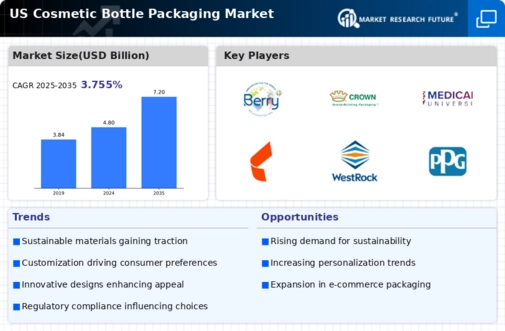Growth of E-commerce and Online Retail
The rise of e-commerce has significantly impacted the cosmetic bottle-packaging market, as more consumers opt for online shopping. In 2025, it is projected that online sales of beauty products will account for approximately 25% of total sales in the US. This shift necessitates packaging that not only protects products during transit but also enhances the unboxing experience for consumers. Brands are increasingly focusing on innovative packaging designs that are visually appealing and functional, catering to the expectations of online shoppers. Additionally, the demand for smaller, travel-sized packaging options is on the rise, as consumers seek convenience and portability. As e-commerce continues to expand, the cosmetic bottle-packaging market must adapt to these changing consumer preferences, ensuring that packaging solutions are optimized for online retail.
Rising Demand for Eco-Friendly Packaging
The cosmetic bottle-packaging market is experiencing a notable shift towards eco-friendly materials, driven by increasing consumer awareness regarding environmental sustainability. As consumers become more conscious of their ecological footprint, brands are compelled to adopt sustainable packaging solutions. In 2025, it is estimated that over 30% of consumers in the US prefer products with recyclable or biodegradable packaging. This trend is prompting manufacturers to innovate and invest in sustainable materials, such as bioplastics and recycled glass, which are gaining traction in the cosmetic bottle-packaging market. Furthermore, regulatory pressures are also influencing this shift, as governments implement stricter guidelines on plastic usage. Consequently, companies that prioritize sustainability in their packaging strategies are likely to enhance their market position and appeal to a broader customer base.
Regulatory Compliance and Safety Standards
The cosmetic bottle-packaging market is increasingly influenced by regulatory compliance and safety standards, which are essential for ensuring consumer safety and product integrity. In the US, the FDA imposes strict regulations on packaging materials and labeling, necessitating that manufacturers adhere to these guidelines. As consumer safety concerns rise, brands are compelled to invest in high-quality packaging materials that meet safety standards. In 2025, it is expected that compliance-related costs will account for approximately 10% of total packaging expenses in the cosmetic sector. This focus on regulatory compliance not only protects consumers but also enhances brand reputation and trust. Consequently, companies that prioritize safety and compliance in their packaging strategies are likely to gain a competitive edge in the cosmetic bottle-packaging market.
Influence of Social Media and Beauty Trends
Social media platforms play a pivotal role in shaping consumer preferences within the cosmetic bottle-packaging market. Influencers and beauty enthusiasts often showcase products with aesthetically pleasing packaging, driving demand for visually striking designs. In 2025, it is estimated that 70% of consumers in the US are influenced by social media when making beauty purchases. This trend encourages brands to invest in unique and eye-catching packaging that stands out in a crowded market. Moreover, limited edition packaging and collaborations with artists or designers are becoming increasingly popular, as they create a sense of exclusivity and urgency among consumers. As social media continues to evolve, the cosmetic bottle-packaging market must remain agile, adapting to the latest trends and consumer expectations.
Technological Advancements in Packaging Solutions
The cosmetic bottle-packaging market is witnessing a surge in technological innovations that enhance packaging functionality and consumer engagement. Smart packaging solutions, such as QR codes and augmented reality features, are being integrated into cosmetic packaging to provide consumers with interactive experiences. These technologies allow brands to convey product information, usage tips, and promotional offers directly to consumers. In 2025, it is anticipated that the adoption of smart packaging will increase by 15% in the cosmetic sector. Additionally, advancements in manufacturing processes, such as 3D printing, are enabling brands to create customized packaging solutions that cater to individual consumer preferences. As technology continues to advance, the cosmetic bottle-packaging market is likely to see increased competition and differentiation among brands.






















Leave a Comment